【第04讲】微分方程的求解 返回首页
作者:欧新宇(Xinyu OU)
当前版本:Release v1.0
开发平台:Python3.11
运行环境:Intel Core i7-7700K CPU 4.2GHz, nVidia GeForce GTX 1080 Ti
本教案为非完整版教案,请结合课程PPT使用。
最后更新:2024年3月19日
一、微分方程
例8.3 求解微分方程
# Lec0401: 例8.3 微分方程求解
import sympy as sp
x = sp.var('x') # 定义符号型自变量
y = sp.Function('y') # 定义符号函数
eq = y(x).diff(x) + 2*y(x) - 2*x**2 - 2*x # 定义微分方程
res = sp.dsolve(eq, ics = {y(0):1}) # 求解符号解
res = sp.simplify(res) # 对解方程进行化简
res
例8.4 求解二阶线性微分方程
# Lec0402: 例8.4 二阶线性微分方程
import sympy as sp
x = sp.var('x')
y = sp.Function('y')
eq = y(x).diff(x, 2) - 2*y(x).diff(x) + y(x) - sp.exp(x)
con = {y(0):1, y(x).diff(x).subs(x, 0):-1}
res = sp.dsolve(eq, ics = con)
res
例8.5 已知输入信号为 ,试求下面微分方程的解
# Lec0403: 例8.5 三阶线性微分方程
import sympy as sp
t = sp.var('t')
y = sp.Function('y')
u = sp.exp(-t)*sp.cos(t)
eq = y(t).diff(t, 4) + 10*y(t).diff(t, 3) + 35*y(t).diff(t, 2) + 50*y(t).diff(t) + 24*y(t) - u.diff(t, 2)
con = {y(0):0, y(t).diff(t).subs(t, 0):-1, y(t).diff(t, 2).subs(t, 0):1, y(t).diff(t, 3).subs(t, 0):1}
res = sp.dsolve(eq, ics = con)
res = sp.expand(res)
res
例8.6 求解微分方程组
试求: 的解,
其中
# Lec0404: 例8.6 求解微分方程组
import sympy as sp
t = sp.var('t')
x1, x2, x3 = sp.var('x1:4', cls = sp.Function) # 定义符号函数
x = sp.Matrix([x1(t), x2(t), x3(t)]) # 定义列向量
A = sp.Matrix([[3, -1, 1], [2, 0, -1], [1, -1, 2]]) # 定义系数矩阵
eq = x.diff(t) - A@x # @ 表示矩阵乘法
res = sp.dsolve(eq, ics = {x1(0):1, x2(0):1, x3(0):1})
for i in range(0,3):
print(res[i])
res[0] # 使用Notebook渲染方程
Eq(x1(t), 4*exp(3*t)/3 - exp(2*t)/2 + 1/6)
Eq(x2(t), 2*exp(3*t)/3 - exp(2*t)/2 + 5/6)
Eq(x3(t), 2*exp(3*t)/3 + 1/3)
例8.7 求解微分方程 的数值解,并分别画出数值解和符号解曲线
# Lec0405: 例8.7 常微分方程的数值解
import sympy as sp
import numpy as np
import matplotlib.pyplot as plt
from scipy.integrate import odeint
plt.rcParams['font.sans-serif'] = ['Microsoft YaHei'] # 使用微软雅黑字体显示标签
# 1. 计算方程数值解 (求数值解时,若为给出自变量范围,则手动设置自变量)
dy = lambda y, x: -2*y+2*x**2+2*x # 自变量参数在函数参数最后
xt = np.linspace(0,10,20) # 自变量为0~10之间的20个数
yt = odeint(dy, 1, xt) # 求解数值解
plt.plot(xt, yt,'b*', label='数值解') # 数值解曲线通常时离散的
print('x={}\n y={}'.format(xt, yt.flatten()))
# 2. 计算方程符号解
x = sp.var('x') # 定义符号型自变量
y = sp.Function('y') # 定义符号函数
eq = y(x).diff(x) + 2*y(x) - 2*x**2 - 2*x # 定义微分方程
res = sp.dsolve(eq, ics = {y(0):1}) # 求解符号解
resF = sp.lambdify(x, res.args[1], 'numpy') # 符号函数转匿名函数,便于绘图
plt.plot(xt, resF(xt), 'g-', label='符号解') # 符号解曲线通常为连续的
plt.legend() # 显示图例
plt.show()
x=[ 0. 0.52631579 1.05263158 1.57894737 2.10526316 2.63157895
3.15789474 3.68421053 4.21052632 4.73684211 5.26315789 5.78947368
6.31578947 6.84210526 7.36842105 7.89473684 8.42105263 8.94736842
9.47368421 10. ]
y=[ 1. 0.62602641 1.22984684 2.53558993 4.44697152 6.93038668
9.9741067 13.57403808 17.72875205 22.43774998 27.70085783 33.5180149
39.88919996 46.81440558 54.29362919 62.32686994 70.91412747 80.05540166
89.75069248 99.99999996]
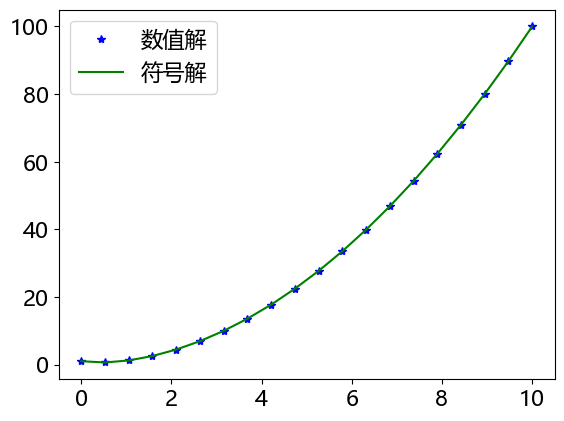
例8.8(序例8.2)二阶常微分方程的数值解(方程8.10)
解:鉴于Python只能求解一阶常微分方程的数值解,因此对于高阶微分方程必须先化简为一阶方程进行求解。对以上公式引入 则方程可转化为如下异界微分方程组:
对以上方程组进行python编程可得:
# Lec0406: 例8.8 二阶常微分方程的数值解
from scipy.integrate import odeint
import numpy as np
import matplotlib.pyplot as plt
plt.rcParams['font.sans-serif'] = ['Microsoft YaHei'] # 使用微软雅黑字体显示标签
dy = lambda y,x: [y[1], np.sqrt(1+y[1]**2)/5/(1-x)] # 定义方程组y[0]=y1, y[1]=y2
x0 = np.arange(0, 1, 0.00001) # 定义x的初值
y0 = odeint(dy, [0, 0], x0) # 使用odeint求解数值解
plt.plot(x0, y0[:,0])
plt.xlabel('x')
plt.ylabel('y', rotation=True)
plt.title('导弹轨迹曲线')
plt.show()
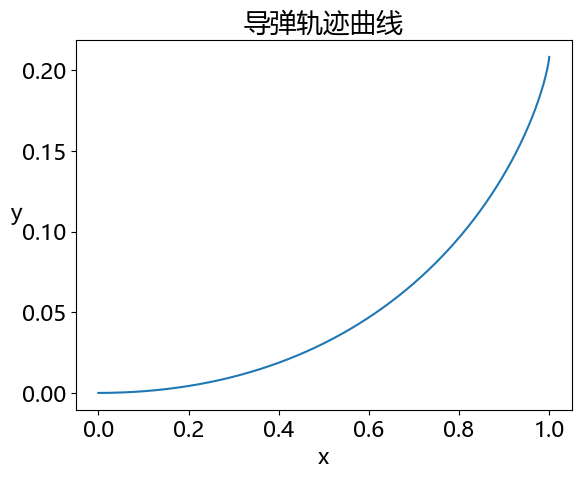
例8.9 Lorenz模型的混沌效应
# Lec0407: 例8.9 Lorenz 模型的混沌效应
from scipy.integrate import odeint
import numpy as np
import pylab as plt
plt.rcParams['font.sans-serif'] = ['Microsoft YaHei'] # 使用微软雅黑字体显示标签
# 1. 定义模型函数
np.random.seed(2) # 为了比较的稳定性,将随机数种子固定
sigma, rho, beta = (10, 28, 8/3)
# 此处使用序列f[0-2]表示公式中的x, y, z, 即状态变量
model = lambda x, t: [sigma*(x[1]-x[0]), rho*x[0]-x[1]-x[0]*x[2], x[0]*x[1]-beta*x[2]] # 定义匿名微分方程组
# 2. 生成初值t0,并求解初值的数值解
t0 = np.linspace(0, 50, 5000)
x01 = np.random.rand(3) #初始值
res1 = odeint(model, x01, t0) #求数值解
plt.figure(figsize=(14,4))
plt.subplots_adjust(wspace=0.6)
ax1= plt.subplot(131, projection='3d')
ax1.plot(res1[:,0], res1[:,1], res1[:,2], 'r') # 画轨线
ax1.set_xlabel('x')
ax1.set_ylabel('y')
ax1.set_zlabel('z')
ax1.set_title('Lorenz模型1')
# 3. 生成第二组初值,给定一个很小的变化量0.000001,并求解新初值的数值解
x02 = x01 + 0.000001
res2 = odeint(model, x02, t0) # 初值变化后,再求数值解
ax2= plt.subplot(132, projection='3d')
ax2.plot(res2[:,0], res2[:,1], res2[:,2], 'r') # 画轨线
ax2.set_xlabel('x')
ax2.set_ylabel('y')
ax2.set_zlabel('z')
ax2.set_title('Lorenz模型2(\delta = 0.000001)')
# 4. 计算两组初值的距离
ax3= plt.subplot(133)
ax3.plot(t0, res1[:,0] - res2[:,0], '.-') #画x(t)的差
ax3.set_xlabel('t')
ax3.set_ylabel('M1-M2', rotation=True)
ax3.set_title('Lorenz模型混沌效应')
plt.show()
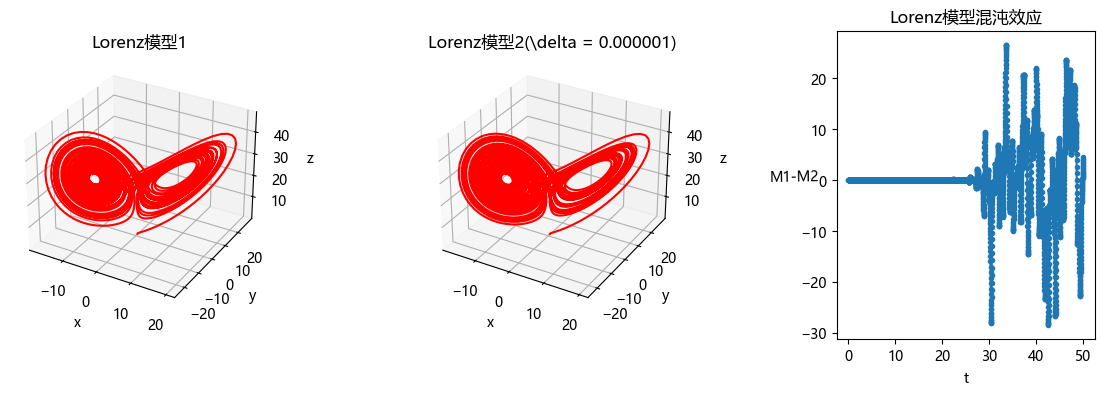
【结果分析】从结果来看,虽然初值之间只有细微的变化 ,但随着时间的推进,两组数值解的轨迹偏差越来越大,呈现出明显的混沌效应。
例8.10 一个慢跑者在平面上按如下规律跑步
突然有一只狗攻击他,这只狗从原点出发,以恒定速率 跑向慢跑者,狗运动方向始终指向慢跑者。分别求出 时,狗的运动轨迹。
相关解答请参考: 【案例07】慢跑者追逐问题
例8.11 求解二阶线性微分方程 ,在区间 [-1, 1] 上的数值解,并与符号解进行比较。
问题分析:
求数值解时,由于 odeint 只能处理一个未知数,因此首先需要做变量替换使用数组变量 表示 和 ,设 ,则二阶微分方程可化成如下的一阶微分方程组:
在以上的微分方程中, 表示初值,因此我们可以将原来的定义域 划分为 以及 两个区域,分别求解数值解。
虽然理论上,数值求解方法(如odeint)可以处理包含0点的连续区间,但在某些情况下,特别是在处理具有奇异点、突变点或数值不稳定性的微分方程时,将区间分割成几部分可能会得到更好的结果。
以下是,计算微分方程符号解与数值解的代码。
# Lec0409: 例8.11 二阶线性微分方程的数值解
from scipy.integrate import odeint
import numpy as np
import sympy as sp
import matplotlib.pyplot as plt
plt.rc('axes', unicode_minus=False) # 解决保存图像时负号'-'显示乱码问题
# 1. 数值解
# 1.1 计算数值解(以0点为分隔,分段计算数值解)
dt = lambda t, x: [t[1], 2*t[1] - t[0] + np.exp(x)] # 定义微分方程
x1 = np.linspace(0, -1, 20) # 生成 [0,-1]的插值区间
s1 = odeint(dt, [1, -1], x1) # 求解数值解主函数
x2 = np.linspace(0, 1, 20) # 生成 [0,1]的插值区间
s2 = odeint(dt, [1, -1], x2) # 求解数值解主函数
# 1.2 绘制数值解曲线
plt.plot(x1, s1[:,0], 'P-', label='numerical solution on [-1, 0]') # 绘制[0,1]上的数值解
plt.plot(x2, s2[:,0], '^-', label='numerical solution on [0, 1]') # 绘制[-1,0]上的数值解
# 2. 符号解
# 2.1 计算符号解
sp.var('x');
y = sp.Function('y')
eq = y(x).diff(x,2)-2*y(x).diff(x)+y(x)-sp.exp(x) # 定义微分方程
con = {y(0):1,y(x).diff(x).subs(x,0):-1} # 定义微分方程的初值
s = sp.dsolve(eq, ics=con) # 求解符号解主函数
sx = sp.lambdify(x, s.args[1], 'numpy') # 转换成匿名函数,其中arg[0]为函数名,arg[1]为函数表达式
x3 = np.linspace(-1, 1, 100); # 生成 [-1,1]的插值区间
s3 = sx(x3) # 基于解析解求解数值解
# 2.2 绘制符号解曲线
plt.plot(x3, s3, 'k-', label='symbolic solution')
plt.title('numerical solution v.s symbolic solution')
plt.legend()
plt.grid(True)
plt.show()
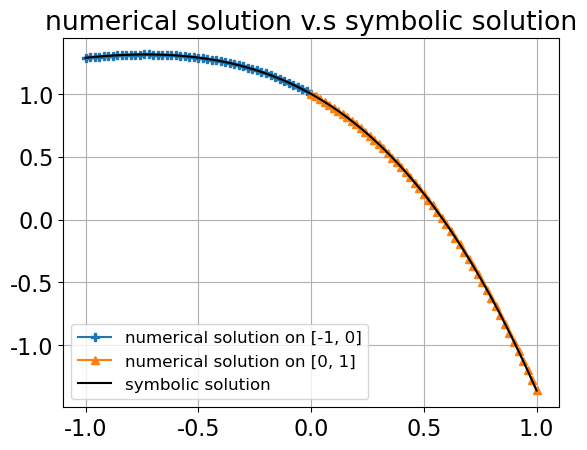
例8.12 已知阿波罗卫星的运动轨迹 (x, y) 满足如下方程:
其中 。设存在初值 ,试求阿波罗卫星的运动轨迹,并绘制出该轨迹图。
将微分方程中的变量替换为 ,其中 ,则原二阶微分方程组可化为如下一阶方程形式:
根据以上方程组,编写Python程序求解阿波罗卫星的运动轨迹如下:
# Lec0410: 例8.12 阿波罗卫星的运动轨迹
from scipy.integrate import odeint
import numpy as np
import pylab as plt
# 1. 定义超参数常数值
mu = 1/82.45
lamda = 1-mu
# 2. 定义微分方程dz: dz_1/dt, dz_2/dt, dz_3/dt, dz_4/dt
dz = lambda z, t: [z[1],
2*z[3]+z[0]-lamda*(z[0]+mu)/((z[0]+mu)**2+z[2]**2)**(3/2)-mu*(z[0]-lamda)/((z[0]+lamda)**2+z[2]**2)**(3/2),
z[3],
-2*z[1]+z[2]-lamda*z[2]/((z[0]+mu)**2+z[2]**2)**(3/2)-mu*z[2]/((z[0]+lamda)**2+z[2]**2)**(3/2)]
# 3. 求解微分方程
t = np.linspace(0, 100, 1001) # 定义自变量t的插值区间
res = odeint(dz, [1.2, 0, 0, -1.0494], t) # 求解微分方程
# 4. 绘制运动轨迹
plt.plot(res[:, 0], res[:, 2]) # plt.plot(x, y) 表示绘制二维曲线
plt.xlabel('x')
plt.ylabel('y', rotation=0)
plt.title('Apollo satellite trajectory')
plt.show()
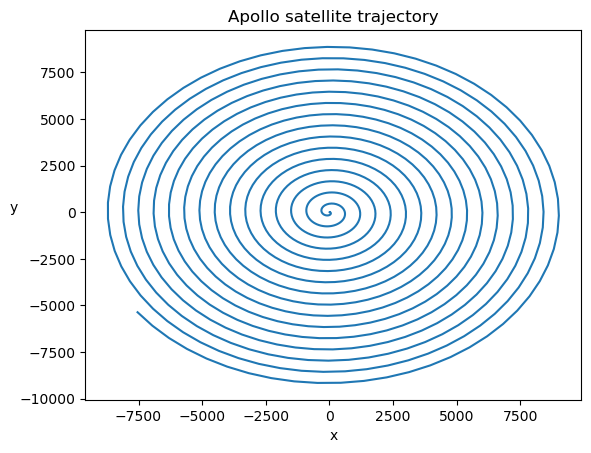
例8.13 利用表8.1给出的近两个世纪的美国人口统计数据(以百万为单位),建立人口预测模型,最后用它预报2010年美国的人口。
# Lec0411: 例8.13 美国人口预测模型
import numpy as np
import pandas as pd
from scipy.optimize import curve_fit
# 1. 数据预处理
data = pd.read_excel('../Data/Lec04/data8_13.xlsx', header=None) # 使用Pandas读取xlsx数据
data = data.values # 将pandas数据转换为numpy数组
data_population = data[1::2,:] # 将第1,3,5行数据存入变量x中,即从第1行开始,以间隔2读取数据,直到最后一行。
data_population = data_population[~np.isnan(data_population)] # 提出有效数据,去掉数据中值为nan的元素
data_year = np.linspace(1790, 2000, 22) # 生成年份序列,也可从数据中读取
# data_year = data[1::2,:] # 将第1,3,5行数据存入变量x中,即从第1行开始,以间隔2读取数据,直到最后一行。
# data_year = data_year[~np.isnan(data_year)] # 提出有效数据,去掉数据中值为nan的元素,此处应注意和人口数据对齐
x0 = data_population[0]
t0 = data_year[0]
year_pred = 2010
# 2. 方法一:非线性最小二乘估计(公式8.32)
x = lambda t, r, x_max: x_max/(1+(x_max/x0-1)*np.exp(-r*(t-t0))) # 设人口数量为 x 简历Logistic人口增长模型(原模型的解)
bd = [(0, 100), (0.1,1000)] # 约束参数人口出生率r和最大人口数的下界和上界
coef1 = curve_fit(x, data_year[1:], data_population[1:], bounds=bd)[0] # 常微分方程建模方法参数
r = coef1[0]
x_max = coef1[1]
pred1 = x(year_pred, r, x_max)
print('方法一:非线性最小二乘估计')
print('人口增长率为:{:.4f}, 最大人口为:{:.2f} 百万'.format(coef1[0], coef1[1]))
print('2010年的预测值为:{:.4f} 百万'.format(pred1))
# 3. 方法二:线性最小二乘估计-前向差分(8.34)
delta_t = 10
n = len(data_population)
b1 = np.diff(data_population)/delta_t/data_population[:-1] #构造常数项列
a1 = np.vstack([np.ones(n-1), -data_population[:-1]]).T
coef2 = np.linalg.pinv(a1) @ b1
r = coef2[0]
x_max = r/coef2[1]
pred2 = x(year_pred, r, x_max)
print('-----------------------------------')
print('方法二:线性最小二乘估计-前向差分')
print('人口增长率为:{:.4f}, 最大人口为:{:.2f} 百万'.format(r, x_max))
print('2010年的预测值为:{:.4f} 百万'.format(pred2))
# 3. 方法三:线性最小二乘估计-后向差分(8.35)
b2 = np.diff(data_population)/delta_t/data_population[1:] #构造常数项列
a2 = np.vstack([np.ones(n-1), -data_population[1:]]).T
coef3 = np.linalg.pinv(a2) @ b2
r = coef3[0]
x_max = r/coef3[1]
pred3 = x(year_pred, r, x_max)
print('-----------------------------------')
print('方法三:线性最小二乘估计-后向差分')
print('人口增长率为:{:.4f}, 最大人口为:{:.2f} 百万'.format(r, x_max))
print('2010年的预测值为:{:.4f} 百万'.format(pred3))
方法一:非线性最小二乘估计
人口增长率为:0.0274, 最大人口为:342.44 百万
2010年的预测值为:282.6799 百万
-----------------------------------
方法二:线性最小二乘估计-前向差分
人口增长率为:0.0325, 最大人口为:294.39 百万
2010年的预测值为:277.9634 百万
-----------------------------------
方法三:线性最小二乘估计-后向差分
人口增长率为:0.0247, 最大人口为:373.51 百万
2010年的预测值为:264.9119 百万
例8.14 捕食者-被捕食者方程组
# Lec0412: 例8.14 捕食者与被捕食者
import numpy as np
# 1. 数据准备
t0 = np.array([0,1,2,3,4,5,6,8,10,12,14,16,18])
x0 = np.array([60,63,64,63,61,58,53,44,39,38,41,46,53])
y0 = np.array([30,34,38,44,50,55,58,56,47,38,30,27,26])
# 2. 构造差分方程组
dt = np.diff(t0) # 计算t的差分
dx = np.diff(x0) # 计算x的差分
dy = np.diff(y0) # 计算y的差分
equ1 = np.vstack([x0[:-1], -x0[:-1]*y0[:-1], np.zeros((2,12))]).T # 方程1的系数
equ2 = np.vstack([np.zeros((2,12)), -y0[:-1], x0[:-1]*y0[:-1]]).T # 方程2的系数
equs = np.vstack([equ1, equ2]) # 构造线性方程组系数矩阵(公式8.37右边)
Y = np.hstack([dx/dt, dy/dt]) # 构造线性方程组常数项列(公式8.37左边)
# 3. 使用最小二乘方法拟合系数
coef = np.linalg.pinv(equs)@Y # 线性最小二乘法
print('参数 a, b, c, d 的值分别为:', coef)
参数 a, b, c, d 的值分别为: [0.19073636 0.00482605 0.48288662 0.00953575]
例8.15 捕食者-被捕食者方程组(续8.14)
# Lec0413: 例8.15 捕食者与被捕食者(续)
import numpy as np
import sympy as sp
import matplotlib.pylab as plt
from scipy.integrate import odeint
plt.rcParams['text.usetex'] = False
plt.rcParams['font.sans-serif'] = ['Microsoft YaHei']
# 1. 求微分方程的解,获取物种的稳定点
sp.var('x,y')
eq = [0.2*x - 0.005*x*y, -0.5*y + 0.01*x*y]
res = sp.solve(eq, [x,y])
print(' 方程的解一: {};\n 方程的解二: {}'.format(res[0], res[1]))
# 2. 绘制方向矢量场
# 2.1 绘制方向矢量场图
x = np.linspace(0,100,10)
x, y = np.meshgrid(x,x)
u = 0.2*x - 0.005*x*y # 方向分量u
v = -0.5*y + 0.01*x*y # 方向分量v
plt.quiver(x, y, u, v)
plt.xlabel('x')
plt.ylabel('y', rotation=0)
plt.title('方向矢量场')
plt.plot(res[1][0], res[1][1], 'ro', label='Balance Point')
text_BP = '(' + str(int(res[1][0])) + ', ' + str(int(res[1][1])) + ')'
plt.text(res[1][0]+2, res[1][1], text_BP, fontsize=12, color='red')
plt.legend(loc='lower right')
# 2.2 求解常微分方程的数值解
def func(f, t): # 构造微分方程组,也可使用lambda匿名函数进行定义
x, y = f
return [0.2*x-0.005*x*y, -0.5*y+0.01*x*y]
t = np.linspace(0, 100, 1000) # 定义月份自变量t的插值区间
s = odeint(func, [70, 40], t) # 求解常微分方程的数值积分。func: 积分函数,[70, 40] 初始条件,t 时间自变量
# 2.3 根据数值解获取 x, y的取值范围,并可视化到矢量场中
x_min = min(s[:,0])
x_max = max(s[:,0])
print('x 的取值范围:[{}, {}]'.format(x_min, x_max))
y_max = max(s[:,1])
y_min = min(s[:,1])
print('y 的取值范围:[{}, {}]'.format(y_min, y_max))
plt.plot(s[:,0], s[:,1]);
plt.show()
方程的解一: (0.0, 0.0);
方程的解二: (50.0000000000000, 40.0000000000000)
x 的取值范围:[34.22924234120125, 70.0]
y 的取值范围:[21.47710791964677, 66.96332841715827]
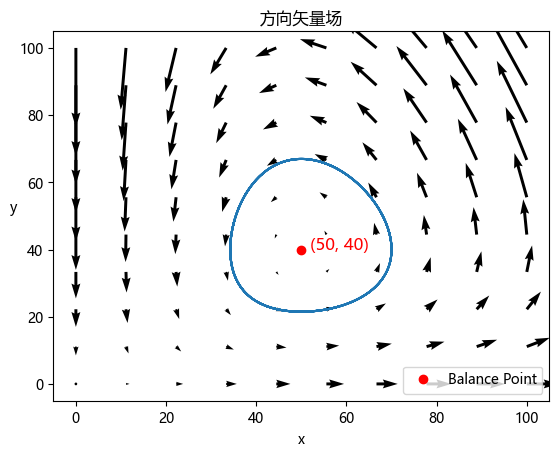
# 3. 绘制兔子x(t)和狐狸y(t) 种群数量变化曲线
import matplotlib
matplotlib.use('TkAgg')
plt.figure()
plt.plot(t, s[:,0], label='x(t)')
plt.plot(t, s[:,1], label='y(t)')
plt.legend()
plt.xlabel('t')
# 以下代码可以通过交互方式计算增长或减少的周期(需要取消TkAgg GUI接口的注释)
print(">>> 请点击x(t)或y(t)解曲线上相邻的极小点(注意确保两个点的纵轴相等,即种群数量相等)!")
x = plt.ginput(2)
print('点击的点', x)
T = x[1][0] - x[0][0]
print("周期T为: ", T)
请点击x(t)或y(t)解曲线上相邻的极小点(注意确保两个点的纵轴相等,即种群数量相等)!
点击的点 [(75.7258064516129, 21.534873267361476), (55.32258064516129, 21.534873267361476)]
周期T为: -20.40322580645161
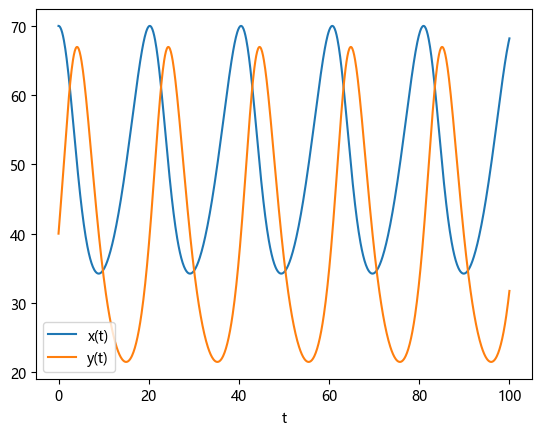
二、差分方程
例8.16 贷款问题
# Lec0414: 例8.16 贷款问题
# 1. 定义初始变量
Q = 300000 # 贷款总额
annual_rate = 0.051 # 年利率
monthly_rate = annual_rate / 12 # 月利率
loan_term_years = 30 # 贷款期限
loan_term_months = loan_term_years * 12 # 贷款期限(月)
# 2. 基于解析法求解每月还款额(根据解析解进行代入计算)
monthly_payment = (1+monthly_rate)**loan_term_months*Q*monthly_rate/((1+monthly_rate)**loan_term_months-1)
print('(解析法)每月应还款金额为: {:.2f} 元'.format(monthly_payment))
# 3. 使用等额本息还款标准公式计算每月还款额
monthly_payment = Q * (monthly_rate / (1 - (1 + monthly_rate)**(-loan_term_months)))
print(f'(公式法)每月应还款金额为: {monthly_payment:.2f} 元')
(解析法)每月应还款金额为: 1628.85 元
(公式法)每月应还款金额为: 1628.85 元
例8.17(续例8.13) 再论美国人口增长模型
# Lec0415: 例8.17 再论美国人口增长模型
import numpy as np
import pandas as pd
# 1. 数据预处理
data = pd.read_excel('../Data/Lec04/data8_13.xlsx', header=None) # 使用Pandas读取xlsx数据
data = data.values # 将pandas数据转换为numpy数组
data_population = data[1::2,:] # 将第1,3,5行数据存入变量x中,即从第1行开始,以间隔2读取数据,直到最后一行。
data_population = data_population[~np.isnan(data_population)] # 提出有效数据,去掉数据中值为nan的元素
A = np.vstack([data_population[:-1], data_population[:-1]**2]).T # 系数矩阵 x_k, x_k^2
coef = np.linalg.pinv(A) @ data_population[1:] # 使用常微分方程建模方法参数
pred = coef[0]*data_population[-1] + coef[1]*data_population[-1]**2 # 输出预测值
print('alpha = {:.4f}, beta = {:.4f}'.format(coef[0], coef[1]))
print('2010年人口预测值为: {:.4f} 百万'.format(pred))
alpha = 1.2095, beta = -0.0004
2010年人口预测值为: 307.6809 百万